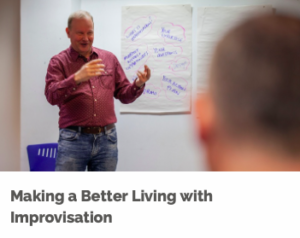Have you ever felt deflated by attending a conference where there’s presentation after presentation – and you seem to get nothing from it?
You sense that the audience is there only so that the speaker is not making pronouncements to a void. While the impact to an empty room would be identical, it might reveal the futility of the event!
Naturally conference audiences respond in kind. They realise they are there not to listen to the presenter, but to put a tick in the attendance box for a professional development credit. The main session offers a relatively quiet period for dealing with emails or indulging favourite daydreams.
The speaker is a disturbance to the audience, and the audience is a terrifying potential disruption for the speaker. They really should give them separate rooms.
This is barely an exaggeration. Only really skilful notetakers gain anything beyond the thrill of seeing the keynoter in the flesh – which is usually minimal. Participants could read the material at three times the speed that presenters speak, if they were considerate enough to email their content to us.
It’s even worse in virtual conferences, where it’s easy for audiences to switch off either literally or metaphorically, with zero fuss.
It doesn’t have to be like that!
The original intention of conference sessions was for an interchange that created value. For the sake of appearances, this promise is preserved in how the marketers describe the event.
Meanwhile, many conference organisers have long realised that most of the benefits of attendance occur in the breaks, the social events and the side meetings.
That doesn’t mean the plenary sessions are a lost cause. They retain the potential to be more than the ritual around which to hang all the other, more worthwhile elements.
How? By turning one-way traffic into two-way or multi-way. This means drawing the audience into interactive relationships with the presenters and each other.
It’s a fundamental recast from people sitting there as passive consumers to active participants, and it can take many forms.
Here are three, ranging from a minimal adjustment to turning the event upside down…
How to make the Q+A count
At a minimum, we can build in a question and answer phase. This turns one-way into two-way, albeit that most of the traffic is still going in one direction.
To be meaningful, we must allocate enough time for the audience to express real curiosity and for the presenter to be ready to grapple with whatever they are asked.
It’s the subtle difference between asking two minutes before a scheduled break, ‘Any questions?’ – and saying, ‘We have ten more minutes with this speaker: what questions would you like to ask?’
Re-energise!
A swift energiser from time to time can lend a well-intentioned boost, but too often audiences find these intrusive and irrelevant.
To be more than half-hearted, the energiser should connect with the topic of the day. If the topic is team-work, for example, make the exercise collaborative.
It’s also neat and effective to build movement into a tactic that will pay off during the session – for example, ask people to sit beside different people, so that they’ll experience a fresh perspective in the next discussion.
Or in a virtual setting, ask them to bring an interesting coffee cup back from a break, so everyone can show them briefly on screen to create more personal connections.
Go upside down – make the groups do most of the work
You can generate energy with movement in all sorts of ways. To make multi-way interactions, send participants out for a walk (or into virtual breakout rooms) in small groups to discuss a presentation or to generate new content.
When they are talking to each other, more people have the opportunity to contribute, and the event fills with new perspectives. The lead presenter becomes a prompt, a provocateur and a reflector, while the group does most of the work.
What if the event is virtual?
Giving everyone a separate room is of course exactly what’s happened with online events.
When everyone in the audience turns their camera off, the presenter has the experience of speaking into a void. By contrast, if we encourage all the cameras to stay on, it’s similar to watching an audience in a lecture hall, with plenty of clues as to the levels of engagement.
And the value of Q+A, group activities and so forth, is equally high.
What’s the measure of success?
Finally, you can judge the success of virtual and face-to-face sessions by watching the audience. Are they disconnected, listening respectfully or learning in the upside-down by fully joining in?
If you want to learn more ways of getting an audience engaged by harnessing energy, movement and group activities, contact us for an Inspirational Facilitator programme online or face-to-face, and let’s build your confidence to make the most of all your participants’ resources, to deliver more effective conference sessions, workshops and meetings.



